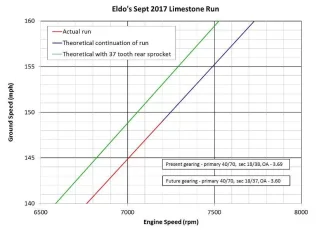lcrken
VIP MEMBER
- Joined
- Mar 15, 2009
- Messages
- 5,038
It's a little surprising how much difference small aerodynamic changes can make in an un-faired bike, particularly when you get up into the 150 mph range. I recall some advice from an old-timer with several speed records when I was first starting at El Mirage. He said making sure you had your toes pointed straight forward instead of hanging down to catch the air made a measureable difference in top speed. This was on a bike with a conventional riding position, and wouldn't be possible in one of the stretched out riding positions on highly modified bikes.
My biggest limitation was not being able to bend my neck enough (arthiritis) to get into a really good tuck and still see ahead. I was complaining to one of the other (much younger) racers, and he said he had improved his ability to tuck in well by doing regular stretching exercises on his neck. Unfortunately, that didn't seem to help me regain lost flexibility. Maybe I need some glasses with prisms to let me look down and see straight ahead. :lol:
The point of all this is that all the small things you are working on are worth the effort. At some point in looking for more speed, the improvements are going to only come in small increments, but those increments add up.
Ken
My biggest limitation was not being able to bend my neck enough (arthiritis) to get into a really good tuck and still see ahead. I was complaining to one of the other (much younger) racers, and he said he had improved his ability to tuck in well by doing regular stretching exercises on his neck. Unfortunately, that didn't seem to help me regain lost flexibility. Maybe I need some glasses with prisms to let me look down and see straight ahead. :lol:
The point of all this is that all the small things you are working on are worth the effort. At some point in looking for more speed, the improvements are going to only come in small increments, but those increments add up.
Ken


